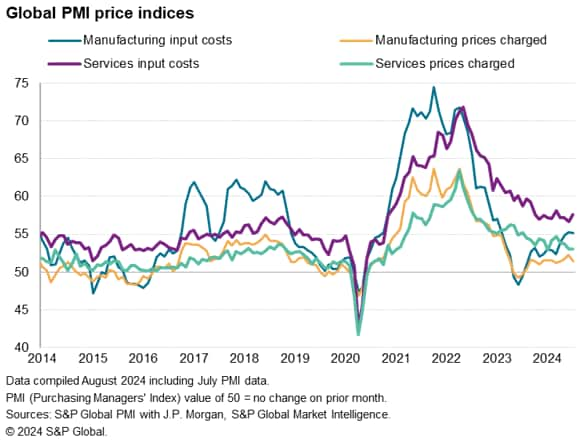S&P Global Offerings
Featured Topics
Featured Products
Events
S&P Global Offerings
Featured Topics
Featured Products
Events
S&P Global Offerings
Featured Topics
Featured Products
Events
S&P Global Offerings
Featured Topics
Featured Products
Events
Corporations
Financial Institutions
Banking & Capital Markets
Economy & Finance
Energy Transition & Sustainability
Technology & Innovation
Podcasts & Newsletters
Corporations
Financial Institutions
Banking & Capital Markets
Economy & Finance
Energy Transition & Sustainability
Technology & Innovation
Podcasts & Newsletters
ECONOMICS COMMENTARY — Aug 05, 2024
Prices charged for goods and services rose globally at the joint-slowest rate since October 2020, according to the July worldwide PMI surveys produced by J.P.Morgan and S&P Global in association with ISM and IFPSM, hinting at inflation dropping in the coming months. Service sector inflation is running globally at the joint slowest since the start of 2021, while manufacturing selling price inflation fell back to a four-month low. The surveys did, however, signal some upturn in cost growth, notably in services.
Global inflation was stuck at 4.4% in June according to early S&P Global Market Intelligence estimates, down from 4.5% in May but still stubbornly high by pre-pandemic standards (an average rate of 2.7% was seen in the decade prior to the pandemic). However, the PMI prices data suggest the rate could cool in the coming months.
The worldwide PMI survey showed average prices charged for goods and services rose globally in July at the joint-slowest rate since October 2020 (matching the prior low seen in January). The latest index reading, at 52.6, remains elevated by the pre-pandemic average of 51.1, but hints at inflation dropping below 4% in the coming months.

Service sector inflation is running globally at the joint slowest since the start of 2021, while manufacturing selling price inflation fell back to a four-month low in July, having risen to a 15-month high in June.
Of the major economies tracked by the PMI surveys, selling price inflation rose most sharply in Brazil followed by Russia, and then followed by the UK, Australia, India and Japan - with inflation ticking higher in most cases compared to June. In nearly all cases, the increases were well above pre-pandemic decade averages to signal stubbornly elevated price pressures by historical standards. Moreover, for Japan, the recent selling prices uptick went against the long-run disinflationary trend.
Rates of price increase meanwhile slowed in the US and eurozone, albeit with the latter showing mixed results by member states, but in both cases still running above pre-pandemic averages.
Prices meanwhile fell in mainland China, albeit only marginally.

Although global selling price inflation moderated in manufacturing and held steady at a low level by recent standards in the service sector globally in July, cost pressures remained a concern among many companies. Measured overall, global input cost inflation accelerated to a ten-month high.
Service sector input costs rose globally in June at the fastest rate for four months, accelerating from June's 44-month low to thereby remain firmly above the pre-pandemic decade average. A steep cooling of services inflation in 2022 has since been replaced with a much more gradual moderation which is showing signs of stalling amid persistent wage-related pressures in particular.
Manufacturing sector input cost inflation meanwhile slowed only marginally from June' s 16-month high, though remains slightly below the pre-pandemic decade average.

Looking at the factors cited by PMI survey respondents as having driven up prices in July, higher labour costs remained the major source of inflationary pressures, as has been the case throughout much of the past two years to varying degrees. However, rising raw material prices are also exerting increasing upward pressure on prices, linked in part to higher shipping rates. Energy costs meanwhile continued to exert a disinflationary impact by historical standards, and demand-pull inflation remained only marginally above its long-run average.

Access the Global Composite PMI press release here.
Chris Williamson, Chief Business Economist, S&P Global Market Intelligence
Tel: +44 207 260 2329
© 2024, S&P Global. All rights reserved. Reproduction in whole or in part without permission is prohibited.
Purchasing Managers' Index™ (PMI®) data are compiled by S&P Global for more than 40 economies worldwide. The monthly data are derived from surveys of senior executives at private sector companies, and are available only via subscription. The PMI dataset features a headline number, which indicates the overall health of an economy, and sub-indices, which provide insights into other key economic drivers such as GDP, inflation, exports, capacity utilization, employment and inventories. The PMI data are used by financial and corporate professionals to better understand where economies and markets are headed, and to uncover opportunities.
This article was published by S&P Global Market Intelligence and not by S&P Global Ratings, which is a separately managed division of S&P Global.
